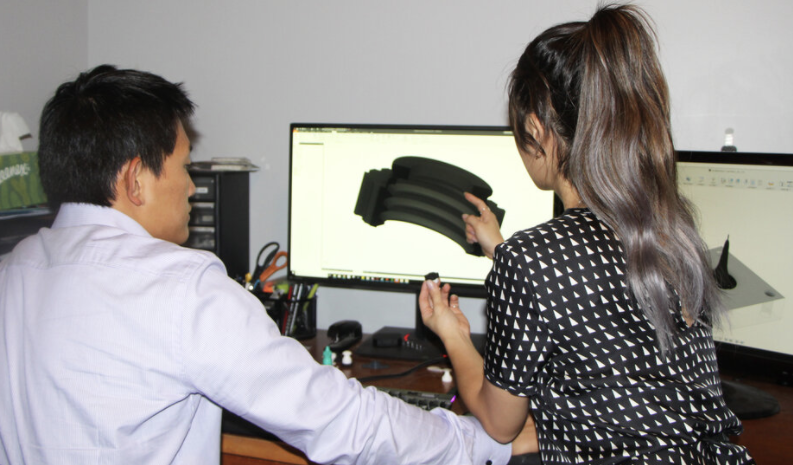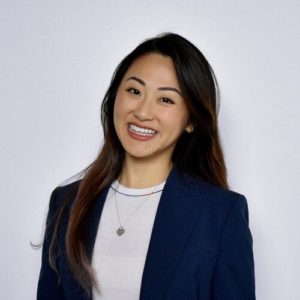

By Kathy Lynn-Cullotta and Ulya Khan, Managing Directors of Golden Seeds and Nanodropper deal leads
June 3, 2021
Imagine having to decide whether to pay the rent or save your eyesight. That’s the dilemma countless people are facing, who need expensive medications to treat eye diseases such as glaucoma. Current eyedrop bottles dispense three to five times as much liquid as the eye can absorb. The excess spills out of the eye and much of the medication goes to waste. Concerned by this situation, a young lab researcher and M.D. candidate at Mayo Clinic named Allisa Song vowed to change it.
Allisa envisioned a simple but effective fix: an adaptor that could fit most eyedrop applicators, reducing droplet size and eliminating waste. She teamed up with a mechanical engineer to develop prototypes, and Nanodropper was born. Allisa, who is co-founder and CEO of the company, recently spoke with Kathy Lynn-Cullotta and Ulya Khan, Managing Directors of Golden Seeds and deal leads, about Nanodropper’s mission to improve vision care and reduce costs.
KLC and UK: Tell us about the origins of your company.
AS: It all started in October 2017, when I read an investigative piece by ProPublica that was reposted by NPR. The title says it all: “Drug companies make eyedrops too big and you pay for the waste.” The article focused on glaucoma, which mostly affects older people, especially women and people of color. As many as one in four patients run out of eyedrops before the month is up because much of the medication is wasted when the eye can’t absorb it all. Every missed drop contributes to irreversible blindness. But it’s a struggle for someone on a fixed income to pay as much as $500 a month for eyedrops. Even with insurance, a 20% copay is a lot. I came up with the idea for an adaptor that would fit onto eyedrop bottles and designed a prototype with Elias Baker, an industry mechanical engineer and a co-founder of Nanodropper. We built a team, won a number of design competitions and in July 2018, incorporated. Over the next two years, we filed a patent and lined up manufacturing, and then launched the product in the summer of 2020.
KLC and UK: What market need are you solving, and how is your approach different from how others have addressed this need?
AS: Our number one goal is to help patients who run out of medication before insurance will pay for the next refill, forcing them to go without or pay out of pocket. There’s no incentive for a drug manufacturer to use a container that dispenses less medication, so we knew this had to be an aftermarket product. Other solutions on the market require a completely new container with narrow, pointy tips, which pose a hazard to the eye. Our product is an aftermarket adaptor that fits most eyedrop applicators. The elongated and flexible silicone tip helps the user aim the drops precisely, and the drops themselves are small enough to be fully absorbed.
Though our focus is on helping patients, we can add value at every level of the industry. By reducing waste, we can improve patient adherence, helping optometrists and ophthalmologists ensure quality care. Fewer early-refill requests mean less administrative work for clinics, insurers, and pharmacies. This supports the healthcare system’s goal to optimize value-based care, improving patient outcomes and reducing costs.
KLC and UK: What challenges have you encountered along the way? How have you overcome them?
AS: One of our biggest challenges was finding manufacturers that would take a chance on us. We’re a very small company in an industry that hasn’t had many startups and no one was interested in small-scale volume production – from creating the injection molds and fabricating the actual parts down to the packaging, labeling and sterilization. We must have called every single manufacturer in a number of states. It took a lot of persistence, due diligence and networking, but we finally found the right partner, and we’re proud that we manufacture everything in the U.S.
Fundraising was another challenge. Although our management team is unique in terms of age and gender, our track record spoke for itself and we’re grateful to have had our initial investors vouch for the pace of our work and our stewardship of the funds they’d invested. At the end of the day, we accomplished a lot as a brand-new medical device company, getting a product on the market in less than two years, with minimal funding.
KLC and UK: How did COVID affect your company?
AS: Like everyone, we had plans for 2020. It should have been a big year for us. We wanted to launch at the beginning of the year and we were timing our funding round to support a marketing push. But then COVID hit, funding got delayed, all the clinics closed, and we took a backseat to the emergent need for other medical devices. It was a difficult time for us, not knowing how and when we would be able to recover, but local support helped us get through this period. As soon as things eased up, we were able to begin manufacturing because we’d chosen to keep production in the U.S. and didn’t have to deal with international supply chain issues. In some ways, our entry into the market was timely, because we helped patients avoid unnecessary expenses and trips to the pharmacy at a time when finances were tight and they wanted to shelter at home.
KLC and UK: What’s coming up next for your company? Any big milestones on the horizon?
AS: This funding round was a big turning point for us, allowing us to think about what’s next in terms of scaling. We’re now partnered with more than 100 clinic locations in the U.S. and plan to increase marketing efforts and sales support to add more clinics and hospital systems. We are in the beginning stages of our clinical trial and have more trials in the works, and we presented at our first academic conference at the American Glaucoma Society in March.
KLC and UK: What advice do you have for early-stage founders?
AS: I attribute a lot of our success and ability to execute to the team dynamic among our four co-founders. The biggest lesson I’ve learned is that picking the right people early on can make or break your company. I believe that character traits are more important than concrete skills. You can acquire skills, but you either have certain traits or you don’t. As we were building our team, the most important things to us were trust, an alignment in values, the ability to be a team player, and self-accountability. We have an amazing team and we’re very deliberate in creating a culture of encouragement in which everyone feels they can contribute ideas and be heard.
KLC and UK: Tell us about your experience with Golden Seeds. How has the Golden Seeds network been helpful to you?
AS: It is an honor to join the list of incredible companies that Golden Seeds has invested in and to be mentored by other women. You have both been wonderful to work with throughout the due diligence process, helping us with connections and introductions. We’re in awe of the depth and breadth of the network of groundbreaking women who have had such impressive careers and are willing to help us succeed to their ranks. We’ve faced difficulties getting started, but we know it’s nothing in comparison to what the pioneering women experienced breaking into new fields as the “firsts”. We’re so grateful for what they’ve done and for their support.
For more wisdom like this from other incredible female leaders, read more on Golden Seeds’ blog.